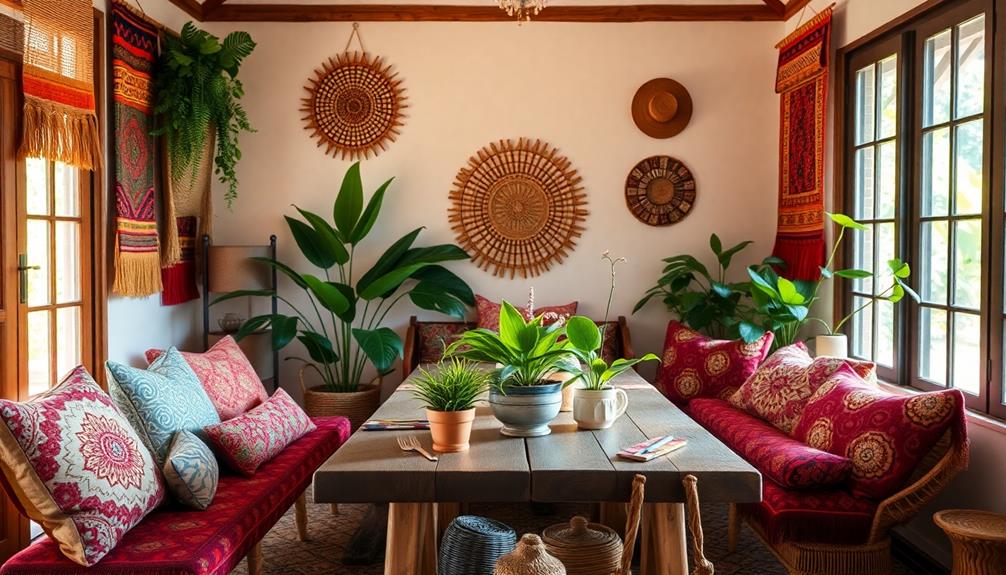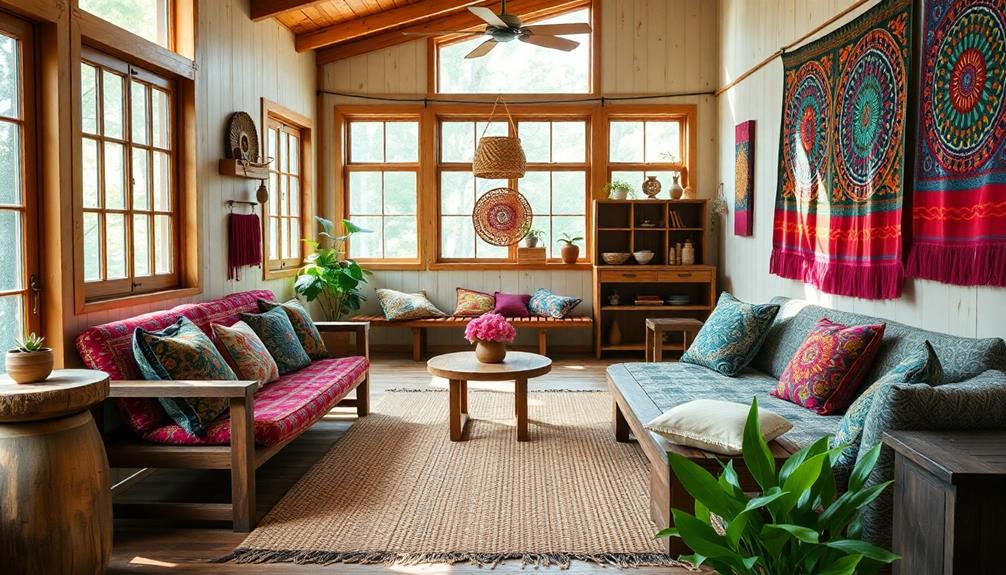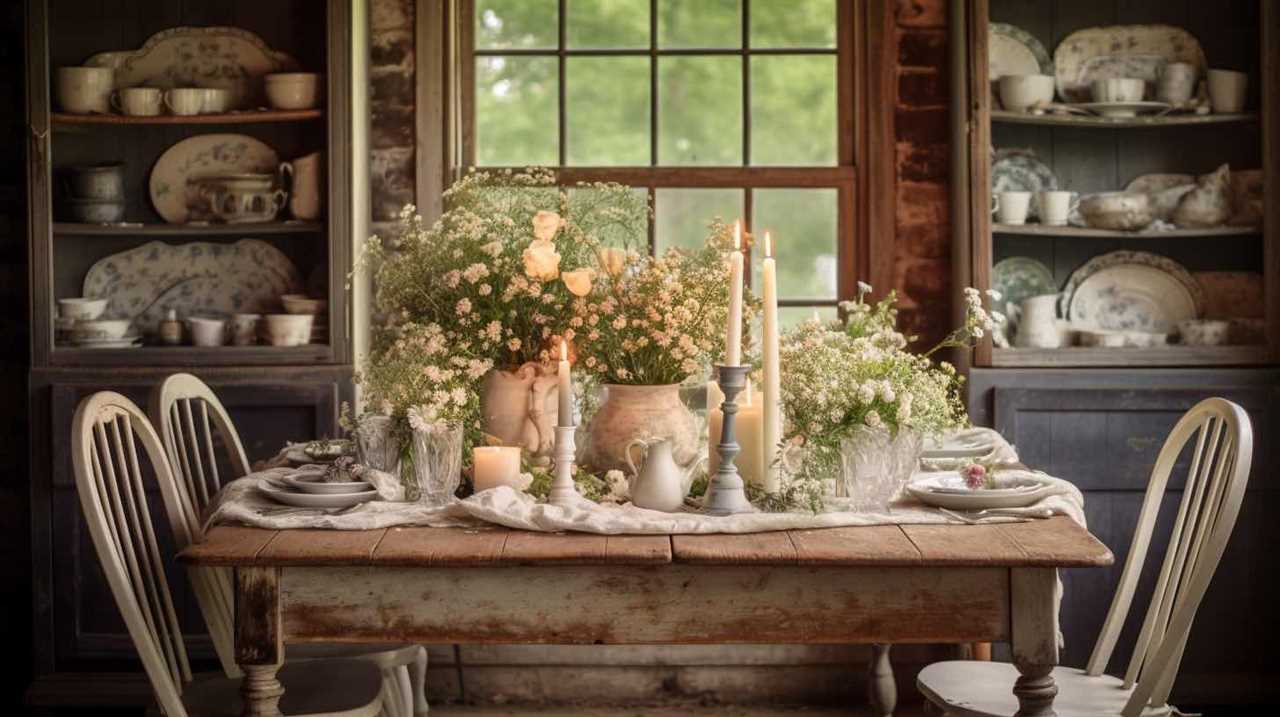You can access the hidden elegance of Indonesian textiles in your farmhouse design by embracing their rich history and vibrant patterns. Incorporate stunning batik fabrics and intricate weaves to add warmth and character to your space. The deep hues and unique motifs create striking contrasts with neutral tones, introducing visual interest and cultural depth. Layer cushions, rugs, and wall hangings for a cozy atmosphere that tells a story while supporting sustainable practices. By selecting these exquisite textiles, you not only enhance your decor but also celebrate the artistry of local artisans. There's so much more to explore about this enchanting design choice!
Key Takeaways
- Incorporate vibrant Indonesian textiles, such as Batik, to add rich color and cultural depth to your farmhouse decor.
- Utilize intricate patterns and natural dyes to create a warm, inviting atmosphere that highlights craftsmanship and sustainability.
- Layer textiles through cushions, rugs, and throws to enhance visual interest and texture in your farmhouse design.
- Feature statement pieces, like gold-wrapped thread fabrics, to spark conversation and showcase the artistry of Indonesian culture.
- Mix traditional motifs with minimalist elements to create a harmonious balance, transforming your space into a unique and elegant retreat.
Embracing Indonesian Textile History

When you explore the world of Indonesian textiles, you'll uncover a rich tapestry of history that's been woven over centuries. These textiles, including batik and ikat, embody techniques that have been passed down through generations, each telling a unique story.
Traditional artistry is evident in the vibrant patterns and colors, reflecting the diverse cultures across Indonesia. Batik, recognized by UNESCO as an Intangible Cultural Heritage, utilizes a wax-resist dyeing method to create intricate patterns that reflect local traditions and beliefs.
Meanwhile, ikat showcases a vibrant dyeing technique, where threads are dyed before weaving, resulting in stunning, blurred patterns.
Incorporating Indonesian textiles into your farmhouse style not only enhances the aesthetic but also honors the cultural significance behind each piece. These textiles often carry deep meanings, used in ceremonies and rituals, making them more than just decorative items.
By choosing to include these textiles in your design, you support local artisans who rely on traditional methods and sustainable practices, helping to preserve their cultural identity.
Embracing Indonesian textile history in your farmhouse design brings warmth and character, allowing you to connect with a vibrant heritage while creating a unique and meaningful space.
Key Characteristics of Indonesian Fabrics
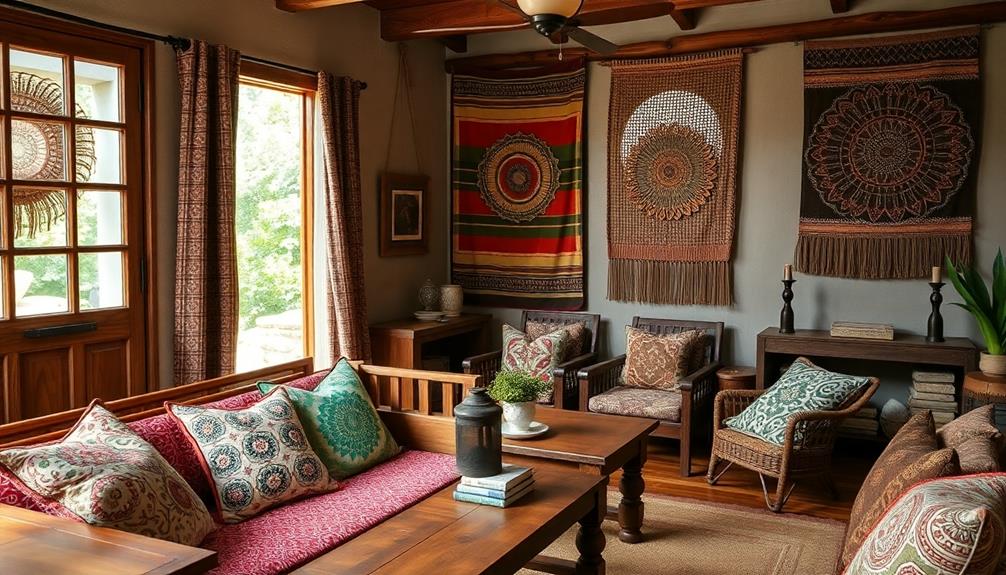
Indonesian fabrics stand out for their intricate patterns and vibrant colors, enchanting anyone who encounters them. These textiles, such as batik and ikat, reflect the rich cultural stories and traditions of various Indonesian regions. The use of natural dyes from indigenous plants and minerals gives these fabrics their stunning earthy tones, enhancing their natural beauty while promoting eco-friendliness in your home decor.
Additionally, the versatility of these textiles allows them to blend seamlessly into various design styles, from rustic to modern, making them an excellent choice for any farmhouse aesthetic. Incorporating Indonesian Decorative Pillows can also provide comfort while showcasing these beautiful fabrics.
One of the most striking features of Indonesian textiles is the meticulous craftsmanship involved in traditional weaving techniques. For instance, the double ikat method dyes both the warp and weft threads before weaving, resulting in unique designs that are highly prized.
You'll also find symbolic motifs, like the Naga (dragon) and floral patterns, deeply rooted in local culture, each carrying specific meanings or blessings.
If you're aiming for elegance in your farmhouse design style, fabrics like songket, woven with gold or silver threads, exemplify luxurious craftsmanship. Incorporating these exquisite textiles not only adds sophistication but also a touch of cultural heritage, enriching your living space with artistry and history.
Embrace the beauty of Indonesian fabrics and transform your farmhouse into a stylish sanctuary.
Integrating Textiles Into Farmhouse Decor

When you integrate Indonesian textiles into your farmhouse decor, the rich color palettes can really enhance your space.
These textiles often feature intricate designs and vibrant colors, much like the Face Indonesian Decor Mask, which represents the rich Indonesian cultural heritage.
Think about how cultural symbolism in fabrics can tell a story while mixing patterns and textures adds visual interest.
Textile Color Palettes
Incorporating vibrant and earthy color palettes from Indonesian textiles can transform your farmhouse decor into an enchanting space. Think deep reds, rich blues, and natural browns that enhance the warm, inviting ambiance typical of modern farmhouse design.
These textile color palettes not only add warmth but also create a stunning visual impact, echoing the cultural storytelling aspect that's intrinsic to Indonesian art.
When you integrate textiles with intricate patterns, like batik or ikat, you introduce cultural depth and unique focal points. A neutral base adorned with colorful accents can harmonize beautifully with your farmhouse aesthetic, ensuring a calming and cohesive look.
Don't overlook the charm of handmade Indonesian textiles. Cushions and throws crafted by artisans not only support local craftsmanship, but they also inject authenticity and character into your decor.
Layering different textile textures, such as woven rugs paired with soft cushions, can further elevate the cozy atmosphere that reflects the rustic charm of farmhouse living.
Cultural Symbolism in Fabrics
Textiles serve not just as decorative elements but also as vessels of cultural significance, especially in farmhouse decor. When you integrate Indonesian fabrics like tapis into your home, you tap into rich cultural symbolism that tells a story.
These textiles often showcase intricate designs, with traditional motifs such as the Naga representing maritime traditions and themes of prosperity and fertility. Additionally, incorporating natural materials and earth tones found in Balinese design concepts can further enhance the overall aesthetic of your space.
By incorporating these meaningful pieces, you create an inviting atmosphere that blends rustic charm with cultural storytelling. Imagine using vibrant wall hangings or upholstery that not only add visual interest but also connect your space to the heritage of Indonesian artisans.
These fabrics introduce different textures, enhancing the tactile experience of your farmhouse while celebrating craftsmanship.
Moreover, choosing to include Indonesian textiles supports sustainable practices, encouraging the preservation of traditional techniques and local artistry. As you select unique pieces for your decor, remember that each fabric carries a narrative—transforming your farmhouse into a space that reflects both elegance and depth.
Embrace the cultural symbolism within these textiles, and enjoy the warmth and character they bring to your home.
Mixing Patterns and Textures
A vibrant mix of patterns and textures can transform your farmhouse decor into a visually alluring space. By incorporating Indonesian textiles like batik and tapis, you can introduce unique cultural patterns and rich textures that enhance your interior design. Layering various materials creates depth and engages the senses, turning your home into a tactile experience.
Here's a quick guide to mixing patterns and textures effectively:
| Textile Type | Suggested Use | Key Benefit |
|---|---|---|
| Woven Rugs | Under dining tables | Adds warmth and comfort |
| Patterned Cushions | On sofas and chairs | Introduces visual interest |
| Bold Motifs | As focal points | Enhances minimalist decor |
Strategically placing these textiles in your farmhouse not only promotes sustainable decor but also tells a rich story about their cultural heritage. By emphasizing the Modern Farmhouse Fusion's celebration of imperfections and handcrafted elements, you can create a cohesive style that reflects your personality. So, don't shy away from mixing patterns and textures—embrace them to elevate your farmhouse design!
Color Palettes and Patterns
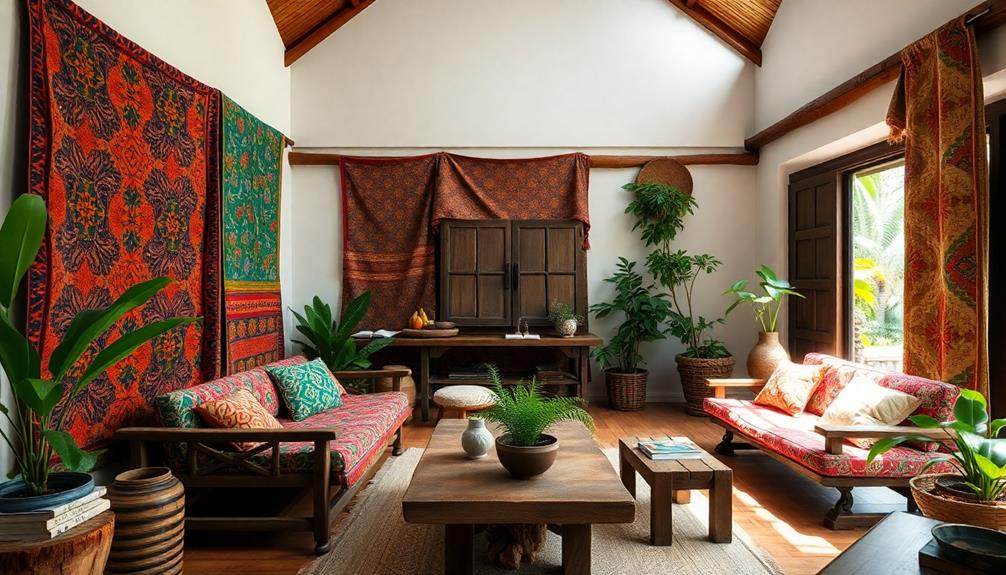
Vibrant colors and intricate patterns define Indonesian textiles, making them an excellent choice for farmhouse design. These textiles showcase rich color palettes, featuring deep indigos, earthy browns, and bright reds.
By incorporating them into your space, you'll not only elevate the aesthetic but also embrace a piece of cultural heritage that reflects traditional Indonesian style home decor. The unique craftsmanship involved in creating these textiles adds an authentic touch to your farmhouse.
Consider these emotional impacts of using Indonesian textiles in your farmhouse:
- Storytelling: Each pattern, like batik or ikat, narrates a tale, connecting your home to the vibrant traditions of Indonesia.
- Natural Inspiration: Motifs often draw from nature, reminding you of the beauty surrounding your farmhouse.
- Visual Interest: The geometric shapes and repetitive designs add a dynamic touch, breaking the monotony of simpler decor.
- Harmonious Balance: Pairing these bold patterns with a neutral color palette creates a stunning contrast between rustic charm and vivid artistry.
Textile Techniques and Craftsmanship

When you explore Indonesian textiles, you'll notice the incredible artistry behind gold-wrapped thread techniques and the couching stitch methodology.
These methods not only add dimension and elegance but also showcase the skill and creativity of the artisans.
Additionally, the rich tradition of using local materials in Indonesian craftsmanship is reflected in the textiles, enhancing their cultural significance and connection to the land.
Understanding these techniques can deepen your appreciation for the diverse architectural styles and beauty inherent in each piece.
Gold-Wrapped Thread Techniques
Gold-wrapped thread techniques in Indonesian textiles showcase the remarkable artistry and craftsmanship that define this cultural heritage. This intricate method involves sewing gold thread onto fabric, creating stunning designs that tell stories of culture and status.
The combination of silk thread securing the gold guarantees durability while accentuating the luxurious quality of these textiles. Incorporating elements from local artisans, such as those found at Mahallati Interiors, can enhance your farmhouse design with unique tropical aesthetics.
When you incorporate gold-wrapped thread pieces into your farmhouse design, consider the emotional impact they can bring:
- Heritage: Each piece carries a rich history, connecting you to Indonesia's vibrant culture.
- Elegance: The shimmering gold threads elevate the aesthetic of any space, adding a touch of sophistication.
- Rarity: Due to the value of gold threads, these textiles are unique and highly sought after, making them conversation starters.
- Craftsmanship: The meticulous process involved showcases artisans' skill, reflecting a deep respect for traditional methods.
Couching Stitch Methodology
The couching stitch methodology serves as a cornerstone in the artistry of Indonesian textiles, showcasing the intricate craftsmanship that defines this cultural heritage. This traditional technique not only highlights the unique styles found in traditional Indonesian housing but also reflects the community's identity and values.
This needlework technique involves laying a thread on the fabric's surface and securing it with small stitches. By doing so, you can create intricate designs and embellishments while minimizing fabric distortion.
Using the couching stitch, you can attach decorative threads, such as luxurious gold or silk, to your textiles. This not only adds a rich texture but also offers a visually engaging appearance, enhancing traditional Indonesian garments.
The technique allows for thicker threads, which can create raised patterns, adding dimension and depth to the designs. This makes it ideal for highlighting motifs in textiles like tapis.
Mastering the couching stitch requires precise control and skill. As you practice, you'll find that it enables you to produce intricate, visually enthralling designs that reflect the craftsmanship and heritage of Indonesian textiles.
Incorporating this elegant technique into your farmhouse design can elevate the aesthetic, offering a unique blend of tradition and artistry that speaks volumes about cultural significance.
Artistry in Textile Creation
Building on the intricate techniques like couching stitch, artistry in textile creation in Indonesia showcases a rich tapestry of craftsmanship that merges tradition with innovation.
The vibrant use of colors and patterns is reminiscent of Indonesian wedding decor ideas, making these textiles not only beautiful but also culturally significant. You can bring this vibrant artistry into your farmhouse design, creating an inviting atmosphere that tells a story.
The textiles aren't just decorative; they embody cultural heritage and meticulous craftsmanship.
Here are four ways these textiles can enhance your space:
- Cultural Connection: Each piece reflects local heritage, making your home a gallery of Indonesian history.
- Luxurious Textures: The use of silk and gold-wrapped threads adds a touch of opulence, perfectly complementing rustic wooden flooring.
- Unique Patterns: Intricate designs from techniques like batik and ikat guarantee that your textiles are one-of-a-kind.
- Sustainable Choices: Locally sourced materials and natural dyes not only beautify your home but also honor the environment.
Incorporating Indonesian textiles into your farmhouse design not only enriches your decor but also celebrates an age-old artistry in textile creation that connects you to a vibrant culture. The intricate patterns and vibrant colors of Indonesian textiles can add a unique and exotic touch to your farmhouse design. Whether used as upholstery, curtains, or accessories, these textiles bring a sense of warmth and authenticity to your space. By incorporating Indonesian textiles, you are not only enriching your decor, but also shaping gorgeous interiors that tell a story of tradition and craftsmanship.
Creating a Cozy Atmosphere

When you incorporate Indonesian textiles into your farmhouse design, you instantly create a cozy atmosphere that invites warmth and connection. The unique textures and intricate patterns of these textiles, like tapis, add a cultural richness that enhances your space.
Use them as statement pieces on a feature wall, drawing attention and sparking conversation among guests.
To achieve a balanced look, opt for a neutral palette that allows the vibrant colors of the textiles to shine. This creates a calm yet visually stimulating environment, perfect for relaxation.
You can layer different textured items, such as woven rugs and soft cushions, to enhance the tactile experience, making your farmhouse feel even more inviting.
Selecting handmade Indonesian textiles not only supports artisan craftsmanship but also reflects your commitment to quality and individuality.
By bringing these elements together, you're not just decorating; you're crafting a narrative of comfort and authenticity in your home design.
Embrace the elegance of Indonesian textiles, and watch how they transform your farmhouse into a sanctuary of coziness and style.
Frequently Asked Questions
Where Can I Buy Authentic Indonesian Textiles for My Farmhouse?
You can buy authentic Indonesian textiles online through reputable marketplaces like Etsy or directly from Indonesian artisans' websites. Local specialty shops and international craft fairs often have unique selections you won't find elsewhere. Happy shopping!
How Do I Care for Indonesian Textiles to Ensure Longevity?
Did you know proper care can extend the life of textiles by up to 50%? To guarantee longevity, gently hand wash in cold water, avoid direct sunlight, and store them in a cool, dry place.
Can I Mix Indonesian Textiles With Other Design Styles?
Absolutely, you can mix Indonesian textiles with other design styles! Their vibrant patterns and rich textures complement various aesthetics. Just balance them with neutral elements to create a harmonious, visually appealing space that showcases your unique style.
What Are the Most Popular Indonesian Textile Types for Decor?
Did you know that over 60 distinct Indonesian textile types exist? For decor, check out Batik, Ikat, and Tenun. Their unique patterns and vibrant colors can transform any space, adding warmth and cultural depth.
Are Indonesian Textiles Eco-Friendly and Sustainably Made?
You'll find that many Indonesian textiles are eco-friendly and sustainably made, utilizing natural dyes and traditional weaving methods. By choosing these textiles, you support local artisans and promote environmentally conscious practices in your decor choices.
Conclusion
By embracing Indonesian textiles, you're not just decorating; you're telling a story. You're inviting warmth, you're adding character, and you're infusing culture into your farmhouse design. With their vibrant colors and intricate patterns, these fabrics transform your space into a cozy retreat. So, let the elegance of Indonesian textiles inspire your creativity, let them spark conversations, and let them create a harmonious blend of tradition and modern comfort in your home.

